01.10.2015
Uninterruptible Power Supply (UPS) is an automatic electronic device, which uses the built-in battery power for the emergency power supply to the devices and its components connected to it with the purpose to finish correctly their operation and to store data in case of a sudden drop or the absence of the input power supply voltage. The main task of an UPS is to provide a trouble-free operation of the equipment connected to it, which is critical to the presence of power supply with normal parameters of the power supply network (computers, control circuits of heating boilers etc.) within a certain time (from several minutes to several hours) depending on its power and the battery set capacity. This time is enough either to remove failures in the power supply line or for a regular power-cut. The UPS is able also to correct parameters (voltage, frequency) of the output network.
UPS CLASSIFICATION
The main characteristics of UPS are:
• output power in volt-amperes (VА) or watts (W);
• output voltage (in volts, V);
• switching time, that is the transition time of UPS to the battery operation (milliseconds, ms);
• off-line operation time determined by the battery capacity and the power equipment connected to UPS;
• input (network) voltage range width, at which UPS is able to stabilize the power supply without passing to the battery operation (volts, V);
• battery life (years, usually lead-acid batteries lose their capacity substantially after 3 years).
Nowadays UPS is a mandatory attribute of modern computer systems, industrial automation devices and industrial process control, instrumentation devices, communication equipment, etc. There is a wide selection of UPS of different power and different topology to meet the requirements of various consumers. International classification of UPS is specified by the standard IEC 62040-3 (1999-03): Uninterruptible Power Systems (UPS) – Part 3: Method of Specifying the Performance and Test Requirements). According to this standard uninterruptible power supplies are divided into three types by topology:
• Off-Line / Passive Standby UPS;
• Line Interactive UPS;
• Double Conversion / On-Line UPS.
Off-Line or Passive Standby UPS
An uninterruptible power supply assembled according to the circuit with a switching device, which during normal operation mode provides the load connection directly to the external power supply network, but during the off-line operation – switch it to the battery operation. Such uninterruptible power supplies serve to backup a source of the main power supply (network) in an emergency (power failure or undervoltage / boosting higher/lower of a preset value). An advantage of an Off-Line UPS is its simplicity, small dimensions and low cost, but its advantage is the nonzero switch time (~4–10 ms) to batteries and more intensive battery operation, because the device switches to the off-line operation mode in any malfunctions in the power supply network.
As a rule, the off-line UPS has small power and is used to provide the trouble-free power supply to separate devices (personal computers, workstations, office equipment) in regions with the power supply network of high quality.
As a whole UPS of this class can be characterized as a compromise between the acceptable protection level against malfunctions in the power supply network and price. The power of produced devices fluctuates from 200 to 2000 VА.
Line-interactive UPS
Line-interactive UPS, as compared with Off-Line UPS, has an additionally installed automatic voltage regulator (AVR) on the basis of an autotransformer with commuted windings (step-voltage regulator). AVR is used in UPS for step adjustment of input voltage toward its increase (with input undervoltage) or decreasing (with input overvoltage). AVR extends the range of input voltages, at which UPS provides regular power supply to the load without switching to the battery operation.
The line-interactive UPS are similar to Off-Line UPS according to the operating principle – they are also used to backup the main power supply source, to filter small power surges and smooth interferences. At the same time, these devices have some substantial differences. For example, the inverter of a line-interactive UPS is connected in parallel to the power supply network and operates in the bilateral mode: it monitors the power supply line and in certain limits provides output voltage correction and stabilization, as well as it charges batteries.
The main advantage of a line-interactive UPS as compared with a reserve type source is that it is able to provide the regular power supply to the load under high or low voltage without switching to the off-line operation mode. As a result, the life of batteries is prolonged. A disadvantage of line-interactive circuit is also the nonzero switch time (~4 ms) of the load to the battery operation.
By efficiency line-interactive uninterruptible power supplies occupy the intermediate position between simple and relatively cheap off-line uninterruptible power supplies and high-performance, but expensive UPS with power double-conversion (On-Line). Line-interactive UPS are widely used to protect personal computers, workstations, units of local computer networks and other equipment.
Double-conversion UPS (On-Line)
Double conversion UPS, which are often named on-line UPS, operate on the other principle. They convert the ac voltage supplied to its input into the dc voltage (this task is performed by a rectifier), and then they convert the dc voltage again into the ac voltage (inverter). Such double conversion allows protecting practically completely the connected load against any malfunctions and interferences in the external power supply network. As in two other types of UPS, the battery starts to operate only in the off-line mode, but it is constantly connected to the inverter’s output, as a result, practically the zero switching time is provided. The on-line circuit provides the ideal output voltage at any malfunctions in the power supply network. It is characterized by the zero switching time from the regular operation mode between a source (rectifier) and the load.
The wrong side of the practically “ideal” protection guaranteed by the on-line UPS are their high complication, cost and a lower coefficient of efficiency (electric power is converted twice). As a rule, on-line UPS are used to protect such devices as file servers and telecommunication equipment.
UPS of this class provide the most reliable protection of the connected equipment against malfunctions in the power supply network and this compensates expenses for its purchasing and installation. The power range of produced devices is very wide – from 600 VА to several hundreds of kilovolt-amperes.
UPS SELECTION
Currently uninterruptible power supplies are used in increasing frequency to protect not only computer but other electronic equipment as well: for example, TV-sets, home cinema systems, expensive acoustic systems etc.
Another field of application of uninterruptible power supplies is protection and off-line power supply to devices of the security and fire alarm, video surveillance systems and other devices installed in a remote object, for example, in a cottage. If we take a look at gas-heating systems of such houses, the electronic control system based on microcontrollers is their main element. Such system consumes a little of electrical power (about 100 W, including a circulation pump), but in case of power supply disconnection the whole heating system will be disconnected as well. Uninterruptible power supplies with a long off-line operation time, which are equipped with a charger to operate with external batteries, can help in such a situation. An important criterion when selecting any product type is its price. As for uninterruptible power supplies, in any case they are considerably cheaper than equipment, which is purchased to protect it. Therefore, we can state with assurance that this purchase is fully justified and will be paid for itself quickly.
The following three main parameters must be taken into account when selecting UPS:
The first one is the load power connected to the UPS. All of us have got used to think that the power is measured in watts (W). However, the output power of UPS is more often specified in volt-amperes (VА). So, the full power of UPS is expressed in volt-amperes, which is calculated as the product of root-mean-squares of current and voltage. However, a part of this power is used for “useful activity” (electrical, light, mechanical, thermal or some else), but a part “settles” in reactive components of equipment (the reactive power characterizes the losses created by reactive components in the alternating-current circuit). It is commonly supposed that the output power of load calculated in watts will be considerably lower than the UPS total power in volt-amperes.
That is why, it is necessary to select an UPS, the power of which exceeds the power of connected load for 20-30 %. Connection of equipment, the power of which exceeds the UPS’s rated power, will lead to the overload of the UPS, to its disconnection and, as a result, to the equipment disconnection.
The second important parameter is the autonomous power supply time to the load. If the main purpose of UPS is a long-term of power supply to an alarm system or gas heating system of a cottage, then the autonomous power supply time (as one of UPS’s main characteristics) is directly determined by the battery capacity integrated in the UPS. It is the most expensive and “fastidious” element of an UPS, which you select. The back-up time in every special case depends on the UPS’s power and protected equipment.
The third parameter is an output voltage configuration of UPS. Some types of equipment, for example, electric motors or instrumentation, acutely require the sinusoidal voltage, i. e. the regular sinusoid. But for computers the voltage configuration is not so important. The matter is that the switched mode power supplies are used in them (energy periodically is taken from the input within a relatively short period of time), for which the approximated sinusoid fit perfectly.
Before purchasing an UPS, it is also useful to inquire what problems mostly arise in the power supply in your house. Not to make a mistake with the right selection, it is necessary to find out, what is the origin of these problems, what kind of failures can be expected, and according to these fact to select a suitable type of UPS with a simple or complex protection class.
When selecting an UPS it is necessary to take into account such parameters as a warranty, availability of qualitative technical support, including a service center availability in a city, reputation of an industrial manufacturer at the market. When you buy a well-known reputable brand, then you may rest assured in the reliability and quality of a product, and if there are any problems – in the assured technical support.
Uninterruptible Power Supplies
UPS: DEFINITION, MAIN APPLICATION
Uninterruptible Power Supply (UPS) is an automatic electronic device, which uses the built-in battery power for the emergency power supply to the devices and its components connected to it with the purpose to finish correctly their operation and to store data in case of a sudden drop or the absence of the input power supply voltage. The main task of an UPS is to provide a trouble-free operation of the equipment connected to it, which is critical to the presence of power supply with normal parameters of the power supply network (computers, control circuits of heating boilers etc.) within a certain time (from several minutes to several hours) depending on its power and the battery set capacity. This time is enough either to remove failures in the power supply line or for a regular power-cut. The UPS is able also to correct parameters (voltage, frequency) of the output network.
UPS CLASSIFICATION
The main characteristics of UPS are:
• output power in volt-amperes (VА) or watts (W);
• output voltage (in volts, V);
• switching time, that is the transition time of UPS to the battery operation (milliseconds, ms);
• off-line operation time determined by the battery capacity and the power equipment connected to UPS;
• input (network) voltage range width, at which UPS is able to stabilize the power supply without passing to the battery operation (volts, V);
• battery life (years, usually lead-acid batteries lose their capacity substantially after 3 years).
Nowadays UPS is a mandatory attribute of modern computer systems, industrial automation devices and industrial process control, instrumentation devices, communication equipment, etc. There is a wide selection of UPS of different power and different topology to meet the requirements of various consumers. International classification of UPS is specified by the standard IEC 62040-3 (1999-03): Uninterruptible Power Systems (UPS) – Part 3: Method of Specifying the Performance and Test Requirements). According to this standard uninterruptible power supplies are divided into three types by topology:
• Off-Line / Passive Standby UPS;
• Line Interactive UPS;
• Double Conversion / On-Line UPS.
Off-Line or Passive Standby UPS
An uninterruptible power supply assembled according to the circuit with a switching device, which during normal operation mode provides the load connection directly to the external power supply network, but during the off-line operation – switch it to the battery operation. Such uninterruptible power supplies serve to backup a source of the main power supply (network) in an emergency (power failure or undervoltage / boosting higher/lower of a preset value). An advantage of an Off-Line UPS is its simplicity, small dimensions and low cost, but its advantage is the nonzero switch time (~4–10 ms) to batteries and more intensive battery operation, because the device switches to the off-line operation mode in any malfunctions in the power supply network.
As a rule, the off-line UPS has small power and is used to provide the trouble-free power supply to separate devices (personal computers, workstations, office equipment) in regions with the power supply network of high quality.
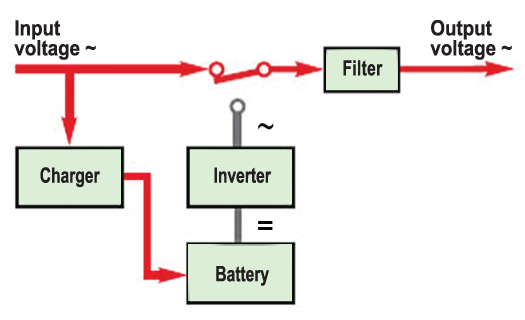
Off-Line (Standby) (normal operation mode) |
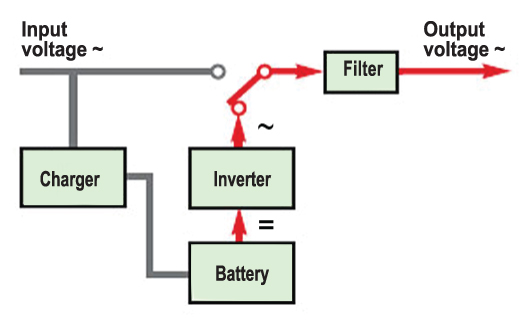
Off-Line (Standby) (off-line operation mode) |
As a whole UPS of this class can be characterized as a compromise between the acceptable protection level against malfunctions in the power supply network and price. The power of produced devices fluctuates from 200 to 2000 VА.
Line-interactive UPS
Line-interactive UPS, as compared with Off-Line UPS, has an additionally installed automatic voltage regulator (AVR) on the basis of an autotransformer with commuted windings (step-voltage regulator). AVR is used in UPS for step adjustment of input voltage toward its increase (with input undervoltage) or decreasing (with input overvoltage). AVR extends the range of input voltages, at which UPS provides regular power supply to the load without switching to the battery operation.
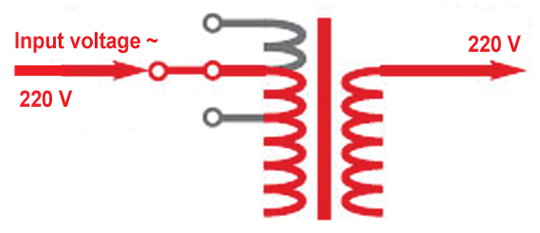
Normal mode |
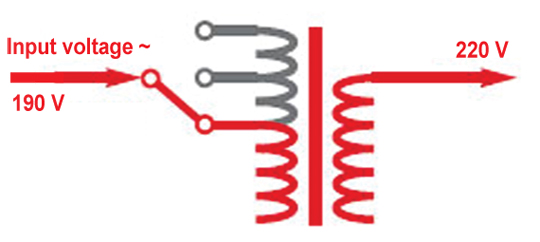
Boost mode |
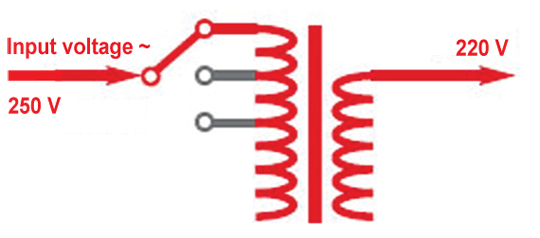
Buck mode |
The line-interactive UPS are similar to Off-Line UPS according to the operating principle – they are also used to backup the main power supply source, to filter small power surges and smooth interferences. At the same time, these devices have some substantial differences. For example, the inverter of a line-interactive UPS is connected in parallel to the power supply network and operates in the bilateral mode: it monitors the power supply line and in certain limits provides output voltage correction and stabilization, as well as it charges batteries.
The main advantage of a line-interactive UPS as compared with a reserve type source is that it is able to provide the regular power supply to the load under high or low voltage without switching to the off-line operation mode. As a result, the life of batteries is prolonged. A disadvantage of line-interactive circuit is also the nonzero switch time (~4 ms) of the load to the battery operation.
By efficiency line-interactive uninterruptible power supplies occupy the intermediate position between simple and relatively cheap off-line uninterruptible power supplies and high-performance, but expensive UPS with power double-conversion (On-Line). Line-interactive UPS are widely used to protect personal computers, workstations, units of local computer networks and other equipment.
Double-conversion UPS (On-Line)
Double conversion UPS, which are often named on-line UPS, operate on the other principle. They convert the ac voltage supplied to its input into the dc voltage (this task is performed by a rectifier), and then they convert the dc voltage again into the ac voltage (inverter). Such double conversion allows protecting practically completely the connected load against any malfunctions and interferences in the external power supply network. As in two other types of UPS, the battery starts to operate only in the off-line mode, but it is constantly connected to the inverter’s output, as a result, practically the zero switching time is provided. The on-line circuit provides the ideal output voltage at any malfunctions in the power supply network. It is characterized by the zero switching time from the regular operation mode between a source (rectifier) and the load.
The wrong side of the practically “ideal” protection guaranteed by the on-line UPS are their high complication, cost and a lower coefficient of efficiency (electric power is converted twice). As a rule, on-line UPS are used to protect such devices as file servers and telecommunication equipment.
UPS of this class provide the most reliable protection of the connected equipment against malfunctions in the power supply network and this compensates expenses for its purchasing and installation. The power range of produced devices is very wide – from 600 VА to several hundreds of kilovolt-amperes.
UPS SELECTION
Currently uninterruptible power supplies are used in increasing frequency to protect not only computer but other electronic equipment as well: for example, TV-sets, home cinema systems, expensive acoustic systems etc.
Another field of application of uninterruptible power supplies is protection and off-line power supply to devices of the security and fire alarm, video surveillance systems and other devices installed in a remote object, for example, in a cottage. If we take a look at gas-heating systems of such houses, the electronic control system based on microcontrollers is their main element. Such system consumes a little of electrical power (about 100 W, including a circulation pump), but in case of power supply disconnection the whole heating system will be disconnected as well. Uninterruptible power supplies with a long off-line operation time, which are equipped with a charger to operate with external batteries, can help in such a situation. An important criterion when selecting any product type is its price. As for uninterruptible power supplies, in any case they are considerably cheaper than equipment, which is purchased to protect it. Therefore, we can state with assurance that this purchase is fully justified and will be paid for itself quickly.
The following three main parameters must be taken into account when selecting UPS:
The first one is the load power connected to the UPS. All of us have got used to think that the power is measured in watts (W). However, the output power of UPS is more often specified in volt-amperes (VА). So, the full power of UPS is expressed in volt-amperes, which is calculated as the product of root-mean-squares of current and voltage. However, a part of this power is used for “useful activity” (electrical, light, mechanical, thermal or some else), but a part “settles” in reactive components of equipment (the reactive power characterizes the losses created by reactive components in the alternating-current circuit). It is commonly supposed that the output power of load calculated in watts will be considerably lower than the UPS total power in volt-amperes.
That is why, it is necessary to select an UPS, the power of which exceeds the power of connected load for 20-30 %. Connection of equipment, the power of which exceeds the UPS’s rated power, will lead to the overload of the UPS, to its disconnection and, as a result, to the equipment disconnection.
The second important parameter is the autonomous power supply time to the load. If the main purpose of UPS is a long-term of power supply to an alarm system or gas heating system of a cottage, then the autonomous power supply time (as one of UPS’s main characteristics) is directly determined by the battery capacity integrated in the UPS. It is the most expensive and “fastidious” element of an UPS, which you select. The back-up time in every special case depends on the UPS’s power and protected equipment.
The third parameter is an output voltage configuration of UPS. Some types of equipment, for example, electric motors or instrumentation, acutely require the sinusoidal voltage, i. e. the regular sinusoid. But for computers the voltage configuration is not so important. The matter is that the switched mode power supplies are used in them (energy periodically is taken from the input within a relatively short period of time), for which the approximated sinusoid fit perfectly.
Before purchasing an UPS, it is also useful to inquire what problems mostly arise in the power supply in your house. Not to make a mistake with the right selection, it is necessary to find out, what is the origin of these problems, what kind of failures can be expected, and according to these fact to select a suitable type of UPS with a simple or complex protection class.
When selecting an UPS it is necessary to take into account such parameters as a warranty, availability of qualitative technical support, including a service center availability in a city, reputation of an industrial manufacturer at the market. When you buy a well-known reputable brand, then you may rest assured in the reliability and quality of a product, and if there are any problems – in the assured technical support.


